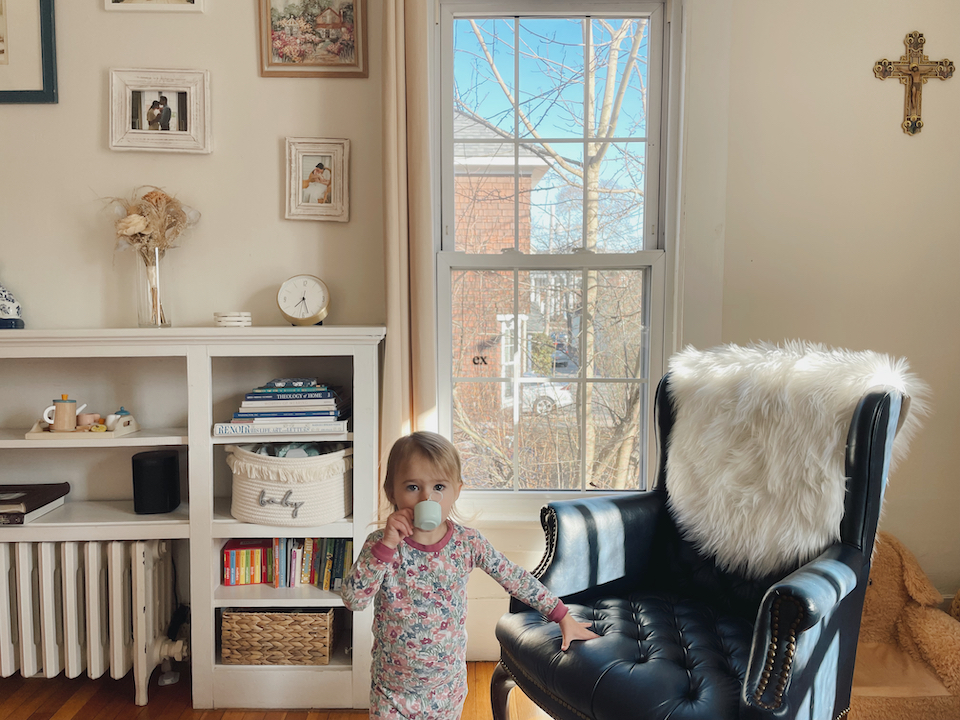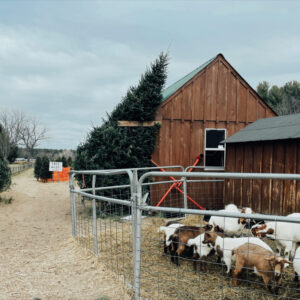My daughter shrugged her shoulders and smiled with squinty eyes as we clinked our respective beverages, imaginary and real, together. I sipped my coffee as she continued to arrange and rearrange her tea set, pouring milk, spooning sugar, and humming happily to herself. Before the day ends, we will have drunk buckets of invisible tea, played hide and seek a million times, and attempted some version of real-life charades that involves me trying to crack the code to her cryptic toddler language. We’ll use pretend play to entertain the 6-month-old, doing anything to hear the fresh ring of his newfound laugh. We’ll fold laundry while playing match the socks and jump on the bed. Our day is a dizzying dance that steps in and out of reality and the imaginary world of childhood.
In the evening, after dinner, my daughter will tug on my leg while I scrape dishes and scrub the countertops, widen her eyes, and raise her eyebrows as she asks me to turn on some music. But even after I play her latest favorite song, she’ll still ask further, “mommy dance?” and look up pleadingly until I acquiesce and clumsily fumble over my own feet as she bounces around the kitchen like a pogo stick. As frustrating as it is to be begged into an activity that interrupts whatever task I’m in the middle of doing, there is delightful freedom in entering into the simplicity of children’s work, that is, their play.
Somewhere between the ages of 7 and 10, when my skill in imaginary play was alive and well while my household duties were just beginning to increase, I remember using my playfulness to complete the dreary household chores. Instead of cleaning the living room as myself, I would become a quirky old lady or a poor orphan. If my cleaning required a visit across the house to retrieve a supply or return a misplaced object, each room I entered allowed a new layer for my self-invented plot to unfold. Getting the dust rag from under the kitchen sink became a sly feat of theft for a clever thief or putting away a toy in the basement became the gifting of a present to an invisible neighbor who just happened to live next to the toy bin. It was a secret world all my own disguised under the common semblance of daily chores.
Sometimes being a mother makes me feel like that child all over again, as a I fall in love with the color pink, play dress up and crawl like a cat on the kitchen floor. The older my children grow, the more I realize that part of my job as a mother is to teach them how to play and enjoy life. They are predisposed to enter the world of play by the environment I create and attitude I encourage. As a stay-at-home mom, there are times when I feel almost guilty for playing, as if there is an imaginary authority shaking its head and telling me to “act my age.” But the more I pay attention to my daughter’s pleas, the more her liveliness rubs off on me and brings animation to my own work. In turn, my work provides structure for her play, feeding her growth with practical tasks to master.
When I was in graduate school, I took a class on Children’s Play where we studied everything from video games to sports and make-believe. We discussed the role of play within their social, cognitive, physical, and emotional development, noting the numerous ways in which play provided the means for children to expand their physical and mental abilities while making sense of confusing realities. Narrative play in particular fascinated me, especially since at the time, I was nannying two girls, one of whom was at an age when her skill for imaginative play was at its peak. From the understanding I was gaining within the classroom, I engaged in play with new eyes, seeing how clearly it gave her the tools to face the frustrations and challenges of a four-year-old. Whenever she displayed aggravation towards a task we needed to accomplish, I would insert a narrative from our imaginative play. When she didn’t want to put on her coat and boots to run an errand, I would suddenly become a character from a story we had acted out. “The cakes need to go into the oven now!” I would exclaim.” Let’s put on our aprons!” Her demeanor would dramatically shift as soon as I suggested this narrative. As soon as her coat became an apron, she would jump to put it on and continue the story, suddenly thrilled to tackle the task at hand.
As my own toddler grows older and her communication skills develop, I continue to see the power of play in coping with daily life. Only now, I see more clearly how beneficial my daughter’s playfulness is within my own growth as a woman and a mother. While my past studies clearly emphasized the role of play in promoting and supporting children’s development, I now recognize how play is just as important for the grown adult.
Within play, we find the freedom to engage in a task without fear of the outcome or the burden of completion. It’s a welcome reprieve from the constant clamor of our daily responsibilities. While it may seem unnecessary, or a waste of time, when we allow our minds to relax, released from pressure, ideas and realizations find their way to the surface and we can process our lives more deeply. So how do we do resurrect this skill we once wielded so well years ago?
- Seek joy!
- Release expectations.
Just like a child on a playground doesn’t map out their actions or check off every slide they tumble down, play should be free from an expected result. Exploration and curiosity are key! And if it doesn’t bring you some level of joy or refreshment, then it isn’t the play for you. Once we can revive a spirit of playfulness within our lives, this joy radiates into our work as well, and we can even apply a playful mentality to tasks that bore or burden us. Learning to play humbles us to not only admit that we need refreshment, but to see the world as a child does: large, overwhelming and sometimes frightening but ripe with opportunities to find delight amidst it all.




